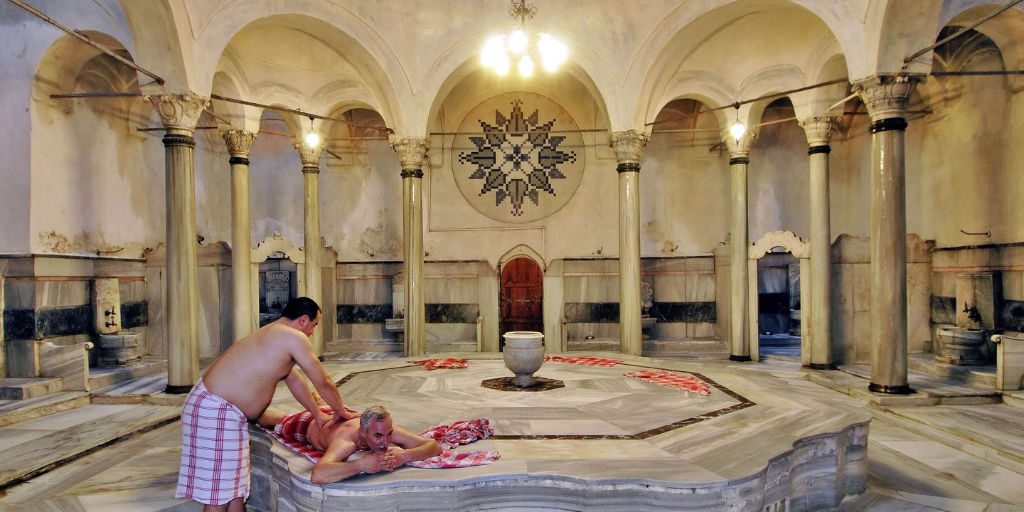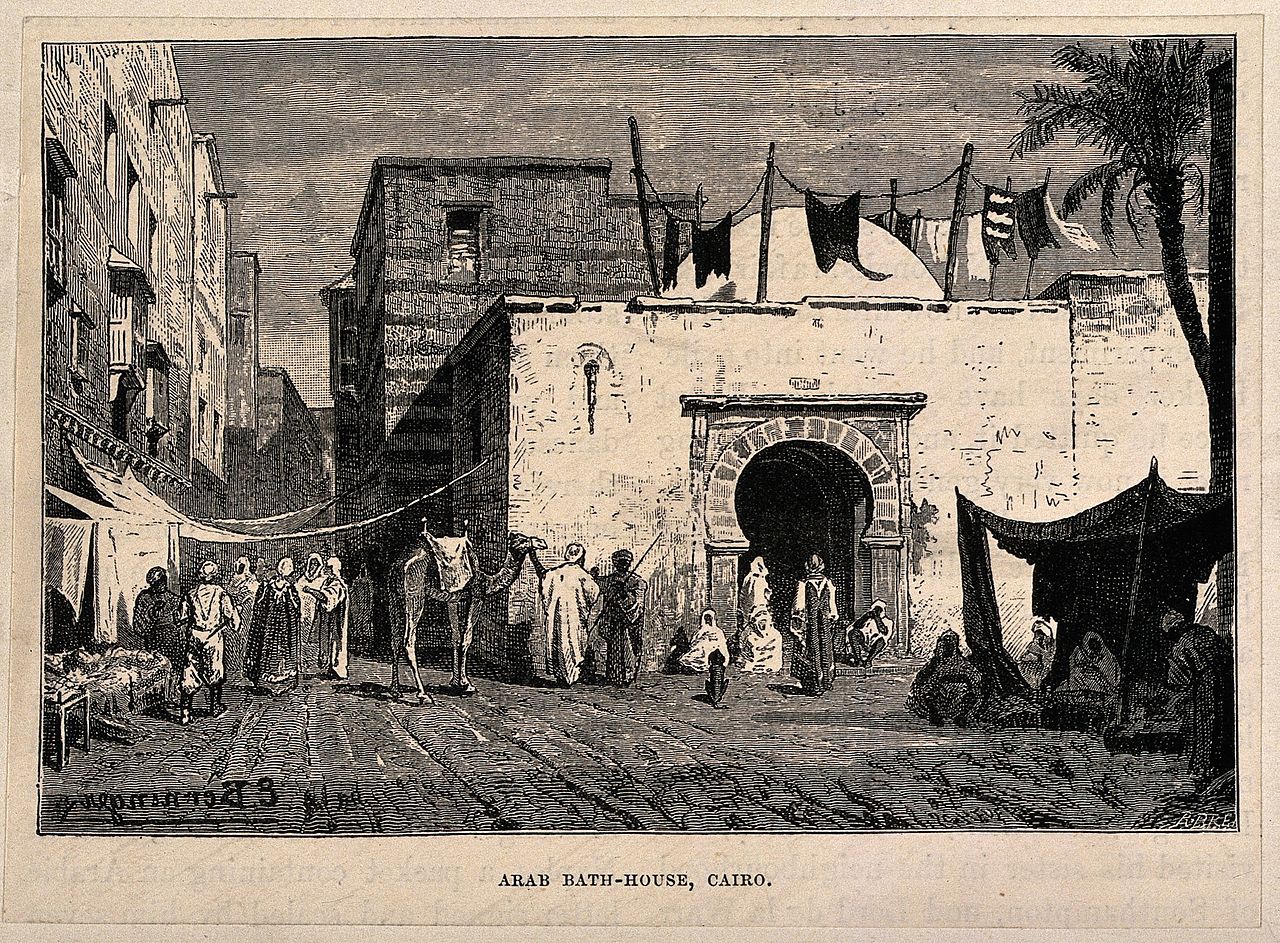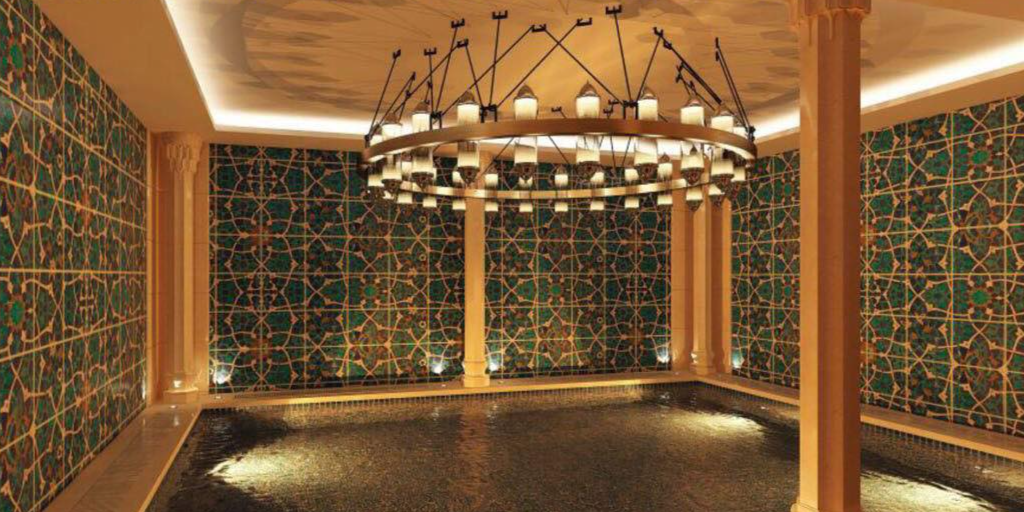Walking into a hammam for the first time, in celebration of a friend’s imminent marriage, is a time capsule of an experience. Hammam Al-Sultan, the establishment in question, is Egypt’s most popular traditional bathhouse, preserving the legacy and aura enjoyed for over a millennium.
Going through the hammam’s Arabesque vintage-wooden doors feels like a Middle Eastern fever dream, as if I have walked into the setting of One Thousand and One Nights.
From the moment I step foot into the bathhouse’s lobby, my olfactory senses are overwhelmed with heavily aromatic incense. My eyes, on the other hand, take their sweet time to grow accustomed to the dim-yet-welcoming yellow lanterns placed on the walls.
A guide, appearing almost out of thin air, quietly leads me past a polished-stone fountain, flowing right in the center of the lounge, and onto an Arab-style seating (neatly cushioned above the mahogany parquet flooring) to lay on until it is time to change into the appropriate attire.
In the 15 or so minutes it takes for it to be my turn, I curiously look around, observing toweled passersby as they go in and out of the bathhouse beyond the lounge. For the most part, they are groups celebrating a groom-to-be. Their loud laughter and banter strike a stark contrast to the lounge’s serene ambience.
In retrospect, there is a tinge of irony in the fact that an Arab man may find a hammam – something culturally intrinsic – so alien. Yet in an Egypt inundated with foreign and modernized spas, seeing a hammam feels out of place.
Another guide, who also mysteriously emerges out of nowhere, snaps me out of my spectation. This time, however, I am directed to the changing room to switch from my casual attire to my swimming trunks, modestly covered by a towel as per bathhouse rules. With a simple nod of approval, the guide silently points towards an entrance: it is my turn to finally enter the bathhouse.
THE HAMMAM EXPERIENCE
The first step, carried out by an amicable worker who seemingly cannot stop smiling, involved being covered in a body scrub from head to toe, followed by washing it off. Once with cold water and then again with hot water.
Smiling once more, the man leads me to the steam room, instructing me and my friends to mingle for about five to ten minutes. The steam masks the room to a degree that makes it virtually impossible to see who is at the other corner of the room. In the lull of the fog, a pleasant aromatic mint smell fills the room, helping clear any blockage in the nostrils.
The second stage – a personal favorite of mine – involves a relaxing dip in a heated pool. It is a nice opportunity to take a second to process the rush that happened in the two steps before and laze around with friends.
Another guide some time later leads me to the third part of the experience – a room where a massage therapist politely waits for me to lie down on a stone slab, proceeding to scrub and exfoliate my entire body.

For anyone not familiar with the physical aspect of spas, this may sound like an unsettling concept. But that sense of unease is often washed away by the professionalism on display by the massage therapist – who makes it his duty to show how much dead skin has been removed in the process.
The fourth stage is a quick visit to the sauna, often lasting five minutes. My friends and I take this as another chance to joke and banter, at least before the heat becomes too unbearable to mingle in. The last step, a dip in the bathhouse’s jacuzzi, erases that sensation.
The jacuzzi is the hammam’s crown jewel. Placed as the focal point of the bathhouse, with a running fountain in the center of it, the jacuzzi is the social hub of the entire location. Due to its large size, the jacuzzi often holds more than one group, giving a sense of liveliness, as if it’s a pool cafe. This is further accentuated by guides serving fresh juice to customers in the jacuzzi.
With the experience reaching its end, I idle in the lounge once more before changing back to my original clothes, somehow feeling more energized than before entering the bathhouse.
Enamored with the experience, I cannot help but wonder why bathhouses are far less culturally relevant than they were a few centuries back. In other words, what put Egypt’s traditional bathhouses out of fashion?
FROM HAMMAMS TO ‘SPAS’
Bathhouses in Egypt date back to the Romans when the empire introduced their thermae (hot) baths to ancient Egypt as places of rest and socialization. The spread of Islam transformed thermaes into the Moorish hammams experienced to this day.
At its peak, Cairo alone housed around 77 operational hammams. This was at the beginning of the nineteenth century.
Over a century later, in 1969, that number dwindled to 33. Today, the country preserves seven restored hammams as heritage sites.
In neighboring countries such as Algeria and Morocco, the historic influence of hammams never waned in the face of modernization.

Image Credit: Wellcome Collection
A more globalized Egypt of today has, instead, prioritized upscale and foreign spa centers – often located within five-star hotels. Those searching for spas will easily find Thai centers or Swedish massages. Today, Hammam Al-Sultan stands as the only recognizable traditional bathhouse in Cairo.
Beyond globalization and modernization, the rise of Islamic fundamentalism helped stain the once-historic reputation of hammams, which had been recently accused of inciting homosexual behavior among men and women.
In 2015, a hammam was raided and 26 customers were arrested on allegations of debauchery. Their arrests were televised, sparking a nationwide scandal that blotched the hammam’s reputation as the Egyptian population largely does not accept the LGBTQ+ community. The detainees were eventually proven innocent and acquitted of their crimes, whereas the television host who broke the news was imprisoned for six months. Nevertheless, the incident further perpetuated the bathhouses’ infamy.
In an era long forgotten, hammams were essential to daily social life. Most citizens would congregate and socialize in public bathhouses, while the more affluent members of society would host friends in their own private bathhouses. Thankfully, bathhouses experienced a return in popularity in recent years, mainly thanks to grooms and brides-to-be, as well as affordability in comparison to foreign spas with prices starting at EGP 400 (USD 20) up to EGP 1140 (USD 60).
It may never regain its stature as a social hub in society, yet I find myself waiting for one of my other friends to get engaged so I can have another excuse to enter through its arabesque wooden doors once more.







Comments (0)